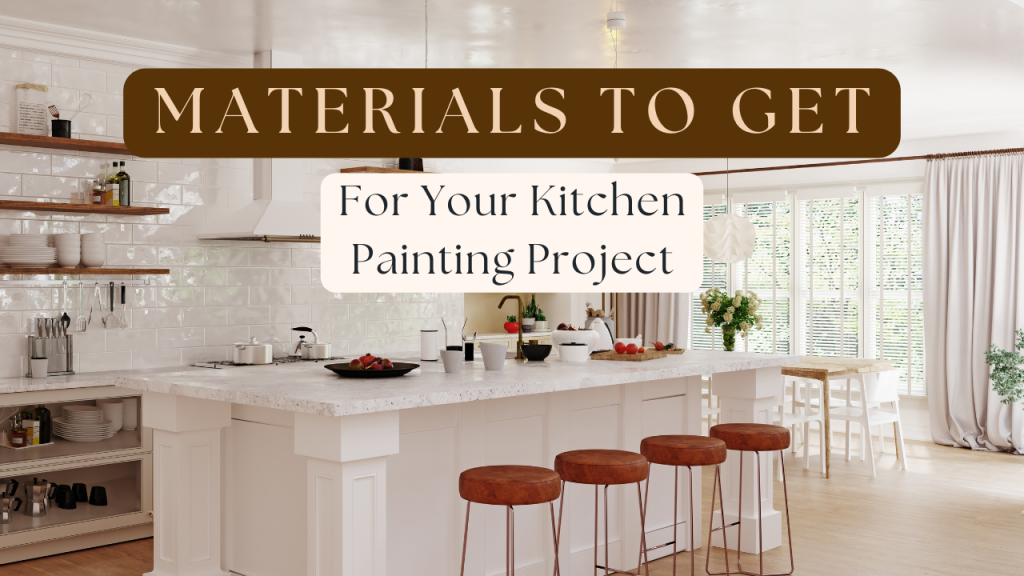Materials To Get For Your Kitchen Painting Project in Holland, PA
If you are looking for a fix for your kitchen space that seems to just get more drab by the day, doing a kitchen painting project might be your best bet.
There’s just nothing a fresh coat of paint can’t fix!
But, it can be daunting to shop for paint materials all on your own, and with the various items and many kinds of painting materials out there, it’s enough to confuse the average homeowner!
So, if you’re looking for help in shopping for materials for your upcoming kitchen painting project, we got you covered.
Here’s a list of Materials To Get For Your Kitchen Painting Project.
1. High-Quality Paint
Of course, in painting your kitchen, you’d have to get paint.
Paint is the center of any painting project, and when it comes to acquiring paint, you must get high-quality paint.
In selecting paint, here are a few factors to consider:
- Paint Type: In painting your kitchen, you’d want to acquire paint made for kitchen painting. Opt for a paint type that could handle constant exposure to heat and moisture, and could be easily cleaned. Additionally, you might want to opt for a mold-inhibiting formula, since molds tend to be common in kitchen spaces.
- Color Selection: Selecting the right color is a vital decision that can significantly impact the overall look and feel of your kitchen. Consider the existing color scheme, the amount of natural light, and your personal preferences when choosing the perfect shade.
2. Painting Supplies
In addition to paint itself, you’ll also need a variety of supplies to help you apply the paint to your kitchen interior.
To have an idea of what to get, here’s a list of tools and materials:
- Paint Brushes and Rollers: Invest in high-quality paint brushes and rollers to achieve smooth and even coverage. Different brushes are suitable for various areas, so make sure you have the right sizes for your project.
- Primer: Don’t forget to purchase a high-quality primer that is suitable for your chosen paint type. Primer helps create a smooth surface for the paint to adhere to and enhances the paint’s longevity.
- Painter’s Tape: Painter’s tape is crucial for protecting areas you don’t want to paint, such as cabinets, countertops, and appliances. It ensures clean lines and prevents paint from bleeding onto unwanted surfaces.
- Drop Cloths: Cover your kitchen floors and countertops with drop cloths or plastic sheets to protect them from paint splatters and spills. This will save you from potential damage and cleanup headaches.
- Paint Trays and Liners: Paint trays and liners are essential for holding and distributing the paint as you work. They help keep your workspace tidy and make it easier to dip your brushes or rollers.
- Sandpaper and Spackling Compound: Before painting, prepare your surfaces by sanding any rough areas and filling in holes or imperfections with spackling compound. Smooth, well-prepared surfaces lead to a better paint finish.
3. Cleaning and Prep Materials
Our kitchens tend to accumulate different kinds of dirt and muck on their surface over time – which, if not removed before painting, could lead to tons of paint problems that will be a hassle to fix.
Thus, making sure that you have cleaning materials for your surface preparation process is important.
Make sure that you have these:
- Degreaser: Kitchens can accumulate grease and grime over time. A degreaser will help you thoroughly clean your walls and surfaces before painting, ensuring that the paint adheres properly.
- TSP (Trisodium Phosphate): TSP is an excellent cleaner and degreaser for kitchen walls and cabinets. It helps remove stubborn stains and ensures a clean surface for painting.
- Sponges and Cleaning Cloths: Use sponges and cleaning cloths to scrub and wipe down surfaces, removing any residue, dust, or dirt that could affect the paint’s adhesion.
- Sandpaper and Putty Knife: As mentioned earlier, sandpaper and a putty knife are essential for surface preparation. Sanding smooths out imperfections, while the putty knife helps apply the spackling compound and remove excess.
4. Safety Gear
In any painting project, safety should always be a top priority.
While doing a kitchen painting project is generally of low-risk, we could never be too safe.
So, here’s a few safety gear you might want to get:
- Respirator or Dust Mask: Paint fumes and dust particles can be harmful when inhaled. A respirator or dust mask will protect your lungs from potentially harmful substances.
- Gloves: Wearing gloves will protect your hands from exposure to cleaning chemicals and paint. Opt for gloves that are suitable for the specific chemicals you’ll be using.
- Electric Fans: Having electric fans present in your kitchen space as you’re painting will help air out dangerous paint fumes off your kitchen space. Also, this could help dry your paint faster.
If you need professional help with your interior/exterior painting project, PAINT Philadelphia can help.
Our home interior/exterior painting services are available in Newtown, Holland, and Richboro, PA.
Call us today at (267)682-8377 for a FREE painting estimate.
Related: Paint Colors To Avoid For Your Home Exterior in Holland, PA
How To Fix The Peeling Paint On Your Home Exterior in Newtown, PA

Andrew Tomasetti is not just a painting contractor, he is the owner of Paint Philadephia; a painting company in the greater Philadephia area that services the Holland, Newtown, Churchville, Yardley, Richboro areas.
Paint Philadephia is an interior, exterior and cabinet painting company that offers their customers top-notch services and their exclusive “On Time, On Dime” guarantee. They take a holistic view to all of their paint jobs offering free color and design consults, test samples, free touch ups on all painting projects, and warranties on all of their work.
Andrew Tomasetti is both a veteran and an engineer. His passion for hands-on work comes from his father and uncle and runs deep in his veins.

